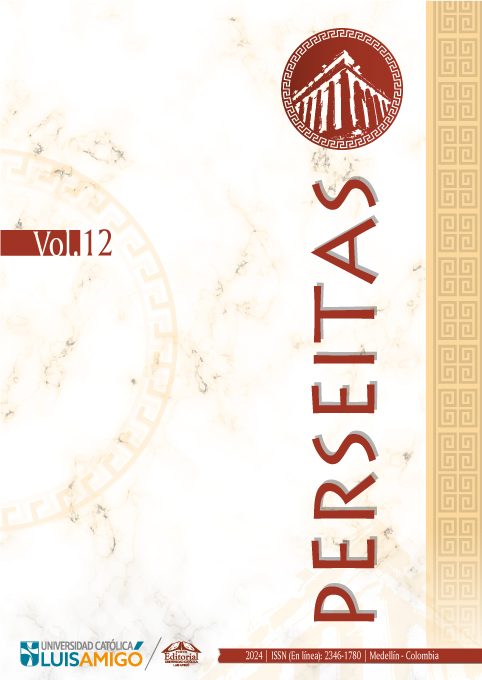Una ética empática como fundamento de la apreciación estética no antropomorfista de los animales
DOI:
https://doi.org/10.21501/23461780.4788Palabras clave:
Animales, Antropomorfismo, Apreciación, Empatía, Estética, ÉticaResumen
Este artículo tiene como objetivo fundamental analizar las bases de una apreciación estética de los animales en clave no antropomorfista, una con la que valorarlos en sus propios términos. Otras apreciaciones tienen un fundamento antropomórfico: la concepción de los animales desde el modelo artístico o desde nuestras necesidades evolutivas, por ejemplo. El contexto de esta investigación es doble: por una parte, la actitud antropomórfica dominante en la cultura moderna y, por otra, las nuevas iniciativas artísticas y culturales alejadas de la comprensión del ser humano como centro de todo lo que existe. La metodología empleada en este estudio es hermenéutica y dialéctica. Hermenéutica porque pretende, ante todo, comprender estas nuevas manifestaciones estéticas animalistas, y dialéctica porque para comprenderlas establecemos un debate crítico con las anteriores posiciones antropocentristas. La conclusión del trabajo es que la apreciación estética de los animales no antropomorfista solo puede fundarse en una ética animalista. Para lograrlo, es necesario, primero, tener conciencia de nuestra tendencia antropomórfica. Y, segundo, adoptar una ética empática que nos permita acceder al punto de vista de los animales, porque solo así podremos percibirlos en sí mismos.
Descargas
Referencias
Barrow, J. (2005). The Artful Universe Expanded. Oxford University Press.
Bekoff, M. (2024). The Emotional Lives of Animals. New World Library.
Bentham, J. (1970/1780). An Introduction to the Principles of Morales and Legislation. Athlone Press.
Berleant, A. (2004). The Aesthetics of Art and Nature. En A. Carlson y A. Berleant (Eds.), The Aesthetics of Natural Environments (pp. 76-88). Broadview Press.
Braidotti, R. (2013). Polity Press.
Brady, E. (2009). Aesthetic Appreciation of Expressive Qualities in Animals. Postgraduate Journal of Aesthetics, 6(3), 1-14.
Budd, M. (2002). The aesthetic Appreciation of Nature. Oxford University Press.
Carroll, N. (1993). On Being Moved by Nature: Between Religion and Natural History. En S. Kemal y I. Gaskell (Eds.), Landscape, Natural Beauty and the Arts (pp. 244-266). Cambridge University Press.
Carlson, A., & Berleant, A. (2004). Introduction: The Aesthetics of Nature. En A. Carlson y A. Berleant (Eds.), The Aesthetics of Natural Environments (pp. 1-42). Broadview Press.
Carlson, A. (1981). Nature, Aesthetic Judgment and Objectivity. The Journal of Aesthetics and Art Criticism, 40, 15-27.
Carlson, A. (2000). Aesthetics and the Environment. The appreciation of nature, art and architecture. Routledge.
Carlson, A. (2019/1979). Appreciation and the Natural Environment. En P. Lamarque y S. Olsen (Eds.), Aesthetics and the Philosophy of Art, The Analytic Tradition. An Anthology (pp. 665-672). Wiley-Blackwell.
Cavalieri, P. (Ed.). (2016). Philosophy and Politics of Animal Liberation. Palgrave MacMillan.
Clutton-Brock, J. (1999). A Natural History of Domesticated Mammals. Cambridge University Press.
Cortés Zulueta, C. (2019). Mirar a las aves mirar… y hacer (arte). Boletín de Arte-UMA, 40, 27-42. https://revistas.uma.es/index.php/boletin-de-arte/article/view/6642
Crawford, D. (2004). The Aesthetics of Nature and the Environment. En P. Kivy (Ed.), The Blackwell Guide to Aesthetics (pp. 306-324). Blackwell.
Darwin, Ch. (2016/1871). El origen del hombre (J. Domènech Ros, Trad.). Austral.
Davies, S. (2012). The Artful Species. Aesthetics, Art and Evolution. Oxford University Press.
Davies, S. (2018). Analyzing Human Adornment. The American Society for Aesthetics Newsletter, 38(2), 1-4. https://cdn.ymaws.com/aesthetics-online.org/resource/resmgr/newsletters/38.2.pdf
Dutton, D. (2003). Aesthetics and evolutionary Psychology. En J. Levinson (Ed.), The Oxford Handbook for Aesthetics (pp. 692-705). Oxford University Press.
Dutton, D. (2009). The Art Instinct. Bloomsbury Press.
Godlovitch, S. (1994). Icebreakers: Environmentalism and Natural Aesthetics. Journal of Applied Philosophy, 11(1), 15-30.
Gould, S. J. (1980). The Panda’s Thumb. More Reflections in Natural History. Norton.
Guthrie, D. (2005). The Nature of Paleolithic Art. University of Chicago Press.
Haraway, D. (2008). When Species Meet. University of Minnesota Press.
Hare, B., Brown M., Williamson, C., & Tomasello, M. (2002). The Domestication of Social Cognition in Dogs. Science, 298(5998), 1634-1636. https://doi.org/10.1126/science.1072702
Hepburn, R. (1966). Contemporary Aesthetics and the Neglect of Natural Beauty. En B. Williams y A. Montefiore (Eds.), British Analytical Philosophy (pp. 285-310). Routledge and Kegan Paul.
Herzog, H., & Burghardt, G. (1988). Attitudes toward Animals: Origins and Diversity. En A. Rowan (Ed.), Animals and People Sharing the World (pp. 75-94). University Press of New England.
Horta, O. (2017). Un paso adelante en defensa de los animales. Plaza y Valdés.
Kramnick, J. (2011). Against Literary Darwinism. Critical Inquiry, 37, 315-347.
Locke, J. (1980/1690). Second Treatise of Government. Hackett.
Low, P. (2012). The Cambridge Declaration on Consciousness. En J. Panksepp et al. (Eds.), Proceedings of the Francis Crick Memorial Conference (pp. 1-2). Churchill College, University of Cambridge.
Mandoki, K. (2007). Everyday aesthetics: prosaics, the play of culture and social identities. Ashgate.
Marchesini, R. (2018). Beyond Anthropocentrism. Thoughts for a Post-Human Philosophy. Mimesis.
Matthews, P. (2019). Scientific Knowledge and the Aesthetic Appreciation of Nature. En P. Lamarque y S. Olsen (Eds.), Aesthetics and the Philosophy of Art, The Analytic Tradition. An Anthology (pp. 673-683). Wiley-Blackwell.
Menninghaus, W. (2003). Das Versprechen der Schönheit. Suhrkamp.
Mitchell, W. T. (1995). Picture Theory: Essays on Verbal and Visual Representation.University of Chicago Press.
Miller, G. (2000). The Mating Mind: How Sexual Choice Shaped Human Nature. Anchor Books.
Nietzsche, F. (1981/1881). Aurora. Meditación sobre los prejuicios morales (P. González Blanco, Trad.). José de Olañeta Editor.
Nietzsche, F. (1980/1887). La genealogía de la moral (A. Sánchez Pascual, Trad.). Alianza.
O’Sullivan, S. (2015). Animals, Equality and Democracy. Palgrave MacMillan.
Parsons, G., & Carlson, A. (2008). Functional Beauty. Clarendon Press.
Parsons, G. (2007). The Aesthetic Value of Animals. Environmental Ethics, 27, 151-169.
Pepperell, R. (1995). The Post-Human Condition. Intellect.
Richter, K. (1999). Die Herkunft des Schönen: Grundzüge der evolutionären Ästhetik. Philipp von Zabern.
Rolston, H. (1987). Beauty and the Beast: Aesthetic Experience of Wildlife. En D. Decker y G. Goff (Eds.), Valuing Wildlife: Economic and Social Perspectives (pp. 187-196). Westview Press.
Rousseau, J-J. (1982/1754). Discurso sobre el origen y los fundamentos de la desigualdad entre los hombres (M. Armiño, Trad.). Alianza Editorial.
Rusow, L-M. (1981). Why Do Species Matter? Environmental Ethics, 3, 101-112.
Saito, Y. (2004). Appreciating Nature on Its Own Terms. En A. Carlson y A. Berleant (Eds.), The Aesthetics of Natural Environments (pp. 141-155). Broadview Press.
Singer, P. (2002/1975). Animal Liberation. HaperCollins.
Tafalla, M. (2017). The aesthetic appreciation of animals in zoological parks. Contemporary Aesthetics, 15. http://www.contempaesthetics.org/newvolume/pages/article.php?articleID=793 (consultado el 27 junio de 2023).
Tafalla, M. (2019). Estética, peletería y extinción de especies. El visón europeo como ejemplo. Azafea, 21, 103-127. https://revistas.usal.es/dos/index.php/0213-3563/article/view/azafea201921103127
Torres, M. (2022). Poder animal. Capacidades y derechos de los animales. Plaza y Valdés.
Wang, X., & Tedford, R. (2009). Dogs: Their Fossil Relatives and Evolutionary History. Columbia University Press.
Wolfgang W. (2004). Animal Aesthetics. Contemporary Aesthetics, 2. https://digitalcommons.risd.edu/liberalarts_contempaesthetics/vol2/iss1/15 consultado el 2 agosto de 2023).
Wittgenstein, L. (1988/1953). Investigaciones filosóficas (A. García Suárez y U. Moulines, Trads.). Crítica.
Wolloch, N. (2006). Subjugated Animals: Animals and Anthropocentrism in Early Modern European Culture. Prometheus Books.
Zangwill, N. (1995). The Metaphysics of Beauty. Cornell University Press.
Publicado
Cómo citar
Número
Sección
Licencia

Esta obra está bajo una licencia internacional Creative Commons Atribución-NoComercial-SinDerivadas 4.0.
La revista y los textos individuales que en esta se divulgan están protegidos por las leyes de copyright y por los términos y condiciones de la Licencia Creative Commons Atribución-No Comercial-Sin Derivar 4.0 Internacional.

















